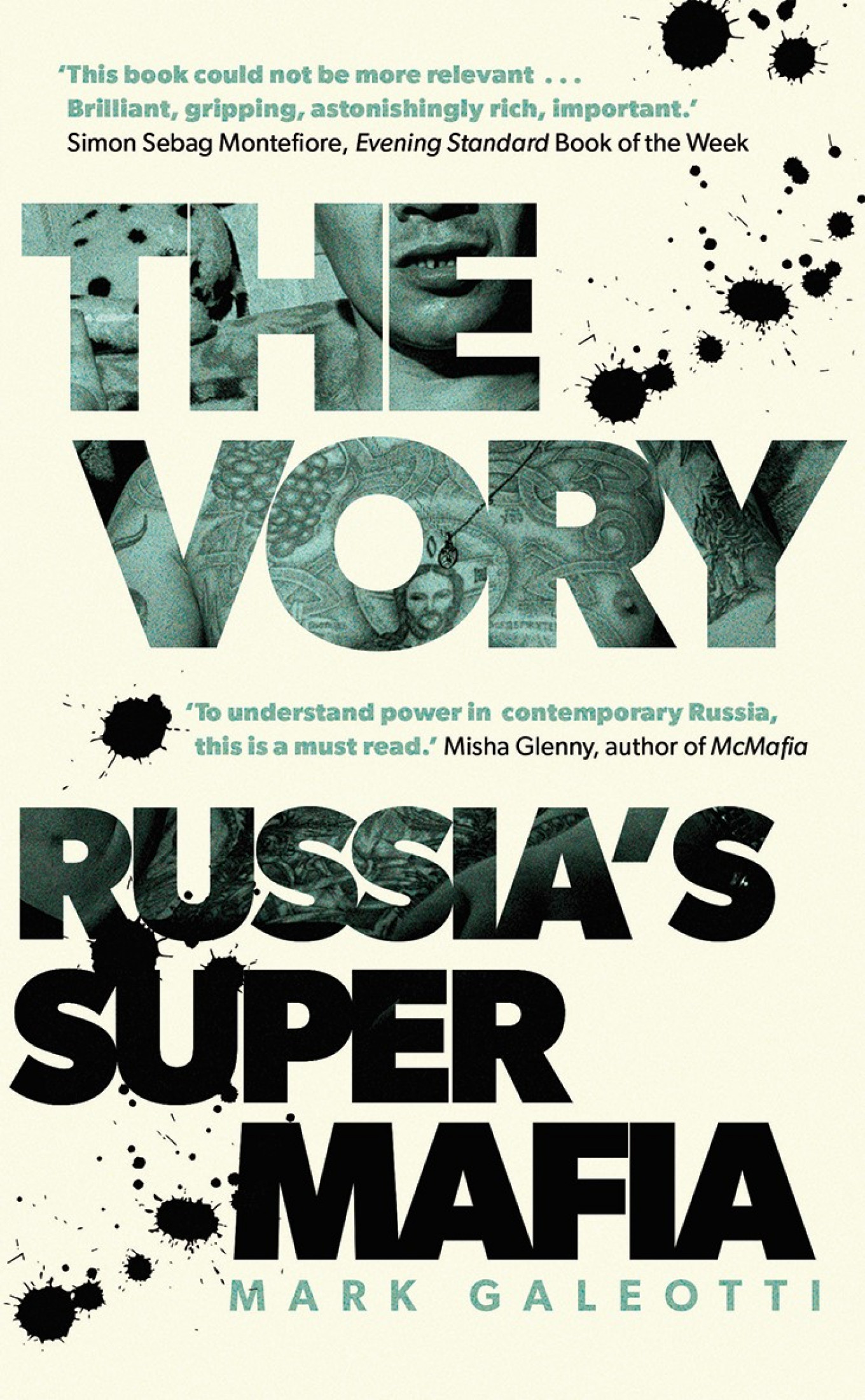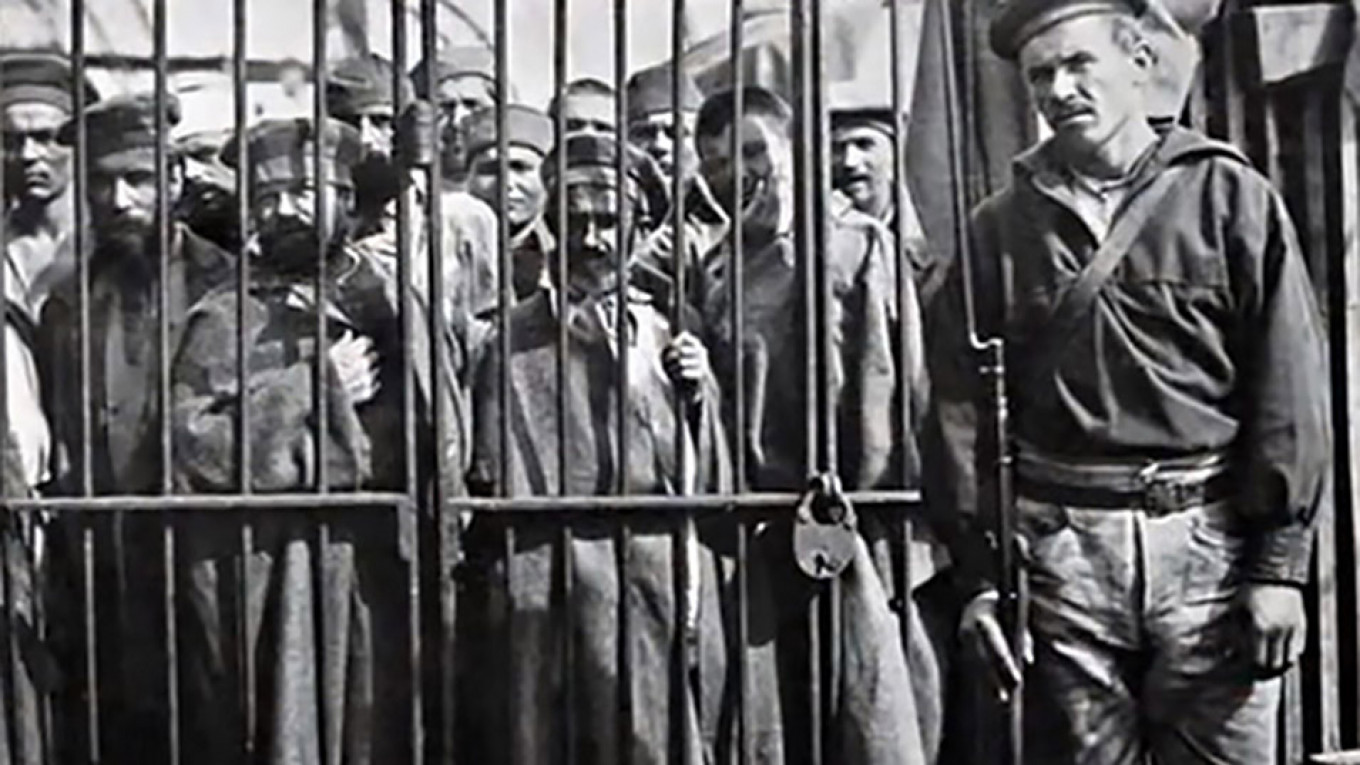In “The Vory: Russia’s Super Mafia,” Mark Galeotti draws on years of research to tell the grimly absorbing tale of Russia’s criminal underworld. Galeotti is a specialist in Russian history, security and crime who is a senior researcher at the Institute of International Relations (Prague); a regular contributor to international news outlets, and advisor to government and law enforcement agencies. He has been studying and writing about security issues and the Russian criminal classes since the 1980s. “The Vory” is both the culmination of decades of study and a primer for specialists and the general reader that charts the rise, fall, and reinvention of the criminal world from imperial Russia up to the present day.
Russian gangsters, Galeotti writes, “hold up a dark mirror to Russian society” in which the boundaries between crime, business and politics are “all too often indistinct.” The book’s central contention is that these gangsters “have not only been shaped by a changing Russia, they have also shaped it.”
Since the end of the 1990s, Russian organised crime has become “regularised, corporately minded and integrated with elements of the state.” If you follow Russian politics, chances are that you have seen the now famous clip of President Putin threatening to “‘whack terrorists, even in the outhouse.” That Putin publicly deployed these terms, Galeotti says, is only possible because of the widescale appropriation of the underworld lexicon by mainstream society. Krysha (roof, i.e., protection), skhodki (meetings), and limonki (little lemons, i.e., one million rubles) are just a few examples of underworld vocabulary – and, indeed, practices – that have become part of everyday political parlance in Russia.
Another central premise of the book is that where there is demand, organised crime supplies. In most cases the demand is for illegal and often violent services, but Galeotti also tells the lighter tale of “cheese runners” who smuggle Western cheese – forbidden by Russian counter-sanctions – into the country through Belarus. If 20 years ago organized crime was “a facilitator within Russia’s still unruly business environment,” today it plays a similar role on a transnational scale.
Another “brand” in the world of vory are Chechen gangs. Part Three describes how Chechen culture and values have shaped this part of the underworld, garnering a reputation for ferocity and a particular kind of honor. Such is the strength of this image, Galeotti demonstrates, that Russian gangs often claim affiliation with Chechen groups to boost their own credibility.
The one demographic group that is largely marginalized in the Soviet and post-Soviet criminal world is absent from the ranks of vory is women. A female underworld of sorts did emerge in Stalin’s Gulags, Galeotti writes, but it was largely “shaped by its masculine counterpart” and denied official status by men. The elaborate and symbolic tattoos boasted by criminals frequently feature women but only as virgins or whores — the only two roles available to them.
Given the multitude of mafia characters in popular culture, it is easy to fall into the trap of glamorizing their exploits and lifestyle. Galeotti, however, treads the line between demonization and vindication. Indeed, “The Vory” disabuses readers of the notion that organised crime consists of Marlon Brando style Godfathers presiding over defined, hierarchized clans. Instead, we are left with a much more unsettling picture of fluid networks with ever-shifting nodes of control. And although people in the West may fear this “global bug bear,” Galeotti reminds readers in the final chapter that it is the Russian people who are “the first and worst victim” of the criminal world of vory.
“The Vory” provides an exhaustively research and comprehensive yet accessible account of the rise and integration of an enormous and fierce criminal class in Russia. If you want to understand contemporary Russian society and politics, this book is essential reading.
By Emily Couch

"The Vory: Russia's Super Mafia"
The wolf may lose his pelt, but never his nature.
Russian proverb
In 1974, a naked body washed up on the coast at Strelna, to the south-west of Leningrad (as St Petersburg was then known). It was not a pretty sight, having been floating in the Gulf of Finland for a couple of weeks. This body may not have been contending with land’s issues of bacteria and insect ravages, but the denizens of the sea had snacked gleefully on the corpse, especially its eyes, lips and extremities. A series of deep knife wounds in the man’s abdomen represented a fairly good indicator of the cause of death.
Yet with no fingerprints, no clothing, and with his face bloated, battered on rocks and partly eaten away, there were none of the conventional clues to identify him. Checking dental records was a possibility, but this was before the true age of the computer and in any case most of his teeth were cheap metal replacements after a life apparently lived on the rough side. There had been no missing-persons notification filed for him. He didn’t even come from the Leningrad region.
Nonetheless, he was identified within just two days. The reason: his body was liberally adorned with tattoos.
The tattoos were the mark of a vor, the Russian word for ‘thief,’ but a general term for a member of the Soviet underworld, the so-called ‘thieves’ world’ or vorovskoi mir, and life in the Gulag labour camp system. Most of the tattoos were still recognisable and an expert on ‘reading’ them was summoned; in this case, a former prison warder turned police investigator.
Within an hour, they had been decoded. The leaping stag on his breast? That symbolised a term spent in one of the northern labour camps. They were known for their harsh regimes and thus survival was a mark of pride in the macho world of the professional criminal. The knife wrapped in chains on his right forearm? The man had committed a violent assault while behind bars, but not a murder. Crosses on three of his knuckles? Three separate prison sentences served. Perhaps the most telling was the fouled anchor on his upper arm, to which a barbed wire surround had clearly been added later: a navy veteran who had been sentenced to prison for a crime committed while in service. Equipped with these details, it was a relatively quick matter to identify the dead man as one ‘Matvei Lodochnik,’ or ‘Matvei the Boatman,’ a former naval warrant officer who some twenty years earlier had beaten a draftee almost to death when his side-line in selling off quartermasters’ supplies had come to light. He was cashiered and spent four years in a labour colony, drifting into the underworld and being sentenced twice more, including a stint at a northern tough-regime camp.
He eventually became a fixture of the underworld in Vologda, some 550 kilometres to the east of Strelna. The police never found out quite why Matvei was in Leningrad and why he died. To be honest, they probably did not really care. But the speed with which he could be identified attests not just to the particular visual language of the Soviet underworld but also to its universality. His tattoos were at once his commitment to the criminal life and also his CV.
Of course, all criminal subcultures have their own languages of sorts, spoken and visual. The Japanese yakuza sport elaborate tattoos of dragons, heroes and chrysanthemums. American street toughs have their gang colours. Every criminal specialism has its technical terms, every criminal milieu its slang. These serve all kinds of purposes, from distinguishing insider from outsider to demonstrating commitment to the group. However, the Russians are truly distinctive in the scale and homogeneity of their languages, both spoken and visual – striking evidence not just of the coherence and complexity of their underworld culture but also their determination actively to reject and even challenge mainstream society. Decoding the detail of the vory’s languages tells us much about their priorities, preoccupations and passions.
The vory subculture dates back to the earlier, tsarist years, but was radically reshaped in Stalin’s Gulags of the 1930s to the 1950s. First, the criminals adopted an uncompromising and unapologetic rejection of the legitimate world, visibly tattooing themselves as a dramatic gesture of defiance. They had their own language, their own customs, their own authority figure. This was the so-called vor v zakone, the ‘thief within the code’ or, literally, ‘thief in law’ – ‘law’ referring to their own, not that of the rest of society.
Over time, the code of the vory would change, as a new generation were enticed by the opportunities in collaborating with a cynical and vicious state on their own terms. The vory would lose their dominance, taking a subordinate role to the barons of the black market and the corrupt Communist Party bosses, but they did not disappear in the grey 1960s and1970s, and as the Soviet system began to grind towards its inevitable collapse, they emerged anew. Again, they reinvented themselves to meet the needs of the moment. In post-Soviet Russia, they blended in with the new elite. The tattoos disappeared, or were hidden beneath the crisp white shirts of a rapacious new breed of gangster-businessman, the avtoritet (‘authority’). In the 1990s, everything was up for grabs, and the new vory reached out with both hands. State assets were privatised for kopeks on the ruble, businesses forced to pay for protection that they might not need, and, as the Iron Curtain fell, the Russian gangsters crashed out into the rest of the world. The vory were part of a way of life that in its own way was a reflection of the changes Russia went through in the twentieth century.
In the process, organised crime – which I have defined elsewhere as ‘a continuing enterprise, apart from traditional and legal social structures, within which a number of persons work together under their own hierarchy to gain power and profit for their private gain, through illegal activities’– truly began to come into its own in a Russia that itself was becoming more organised. Since the restoration of central authority under President Vladimir Putin from 2000, the new vory have adapted again, taking a lower profile, even working for the state when they must. In the process, Russian organised crime has become at once an international bugbear, a global brand and a contested concept. Some see in it an informal arm of the Kremlin, with Russia airily dismissed as a ‘mafia state’. To others, the descendants of the vory are just an inchoate collection of troublesome but unremarkable gangsters. Watch Western media representations, though, and you would be tempted to see them as a global threat in every arena, the most savage of thugs, the most cunning of hackers, the most skilled of killers. The irony is that almost all of these perceptions are true in some ways, even if often misleading or mobilised for the wrong reasons.
The question remains: why, in an age when crime is increasingly networked, international and cosmopolitan, should any ethno-cultural fraction of the global underworld deserve special attention?
The challenge of Russian organised crime is a formidable one. At home, it undermines efforts to control and diversify the Russian economy. It is a brake on efforts to bring better governance to Russia. It has penetrated the financial and political structures of the country and also tarnishes the ‘national brand’ abroad (the Russian gangster and corrupt businessman are ubiquitous stereotypes). It is also a global challenge. Russian or Eurasian organised crime – however this may be defined – operates actively, aggressively and entrepreneurially around the world as one of the most dynamic forces within the new transnational underworld. It arms insurgents and gangsters, traffics drugs and people, and peddles every criminal service from money laundering to computer hacking. For all that, it is as much a symptom as a cause of the failure of the Russian government and political elite to establish and empower the rule of law, while much of the rest of the world remains willing, indeed often delighted, to launder the gangsters’ cash and sell them expensive penthouse apartments.
This book is about Russian organised crime, or perhaps more accurately about organised criminals, and especially the extraordinary and brutal criminal culture of the vory. This criminal subculture has metamorphosed periodically as times and opportunities have changed. The tattooed thugs, whose experiences in the labour camps meant that modern prisons hold no fear for them, have all but adapted themselves out of existence. Modern Russian criminals often even avoid the term vor, ignoring most of the structures and restrictions that used to go with it. They no longer separate themselves from the mainstream, they eschew the tattoos that openly branded them as members of the vorovskoi mir (which is why Matvei would be harder to place these days). But to assume that this means that the vory have disappeared altogether, or that Russian organised crime is no longer distinctive, would be to make a serious mistake. The new godfathers may call themselves avtoritety, have business portfolios stretching from the essentially legitimate to the wholly criminal, get involved in politics and beseen at charitable galas. But they nonetheless are the inheritors of the drive, determination and ruthlessness of the vory, men of whom even a New York mafia boss said, ‘We Italians will kill you. But the Russians are crazy – they’ll kill your whole family.’
The key themes of the book, then, are three. The first is that Russian gangsters are unique, or at least they were. They emerged through times of rapid political, social and economic change – from the fall of the tsars, through Stalin’s whirlwind of modernisation, to the collapse of the USSR –which brought specific pressures and opportunities. While on one level a gangster is a gangster throughout the world, and arguably the Russians are becoming part of an increasingly homogenised global underworld, the culture, structures and activities of the Russian criminals were for a long time distinctive, not least in their relationship to mainstream society.
The second central theme is that the gangsters hold up a dark mirror to Russian society. For all that they often sought to present themselves as being outside the mainstream, they were and still are its shadow, defined by its ways and times. Exploring the evolution of the Russian underworld also says something about Russian history and culture, and is especially meaningful today, at a time when the boundaries between crime, business and politics are important but all too often indistinct.
Finally, Russian gangsters have not only been shaped by a changing Russia, they have also shaped it. Part of the value of this book is, I hope, to address the myths about criminal dominance of the new Russia, but at the same time to look at the ways that its ‘upperworld’ has been influenced by its underworld. As tattooed ex-convicts are replaced by a new breed of globally minded criminal-businessmen, does this represent the house-training of the gangsters or the criminalisation of Russia’s economy and society? Is this a ‘mafia state’ – and what does that even mean?
Do the gangsters run Russia? No, of course not, and I have met many determined, dedicated Russian police officers and judges committed to the struggle against them. However, businesses and politicians alike use many methods that owe more to the vorovskoi mir than legal practice, the state hires hackers and arms gangsters to fight its wars, and you can hear vor songs and vor slang on the streets. Even President Putin uses it from time to time to reassert his streetwise credentials. Perhaps the real question, with which this book ends, is not so much how far the state has managed to tame the gangsters, but how far the values and practices of the vory have come to shape modern Russia.
From “The Vory: Russia’s Super Mafia” by Mark Galeotti
Copyright © 2018 Mark Galeotti
Yale University Press
For more information, see the publisher’s site here.
A Message from The Moscow Times:
Dear readers,
We are facing unprecedented challenges. Russia's Prosecutor General's Office has designated The Moscow Times as an "undesirable" organization, criminalizing our work and putting our staff at risk of prosecution. This follows our earlier unjust labeling as a "foreign agent."
These actions are direct attempts to silence independent journalism in Russia. The authorities claim our work "discredits the decisions of the Russian leadership." We see things differently: we strive to provide accurate, unbiased reporting on Russia.
We, the journalists of The Moscow Times, refuse to be silenced. But to continue our work, we need your help.
Your support, no matter how small, makes a world of difference. If you can, please support us monthly starting from just $2. It's quick to set up, and every contribution makes a significant impact.
By supporting The Moscow Times, you're defending open, independent journalism in the face of repression. Thank you for standing with us.
Remind me later.






